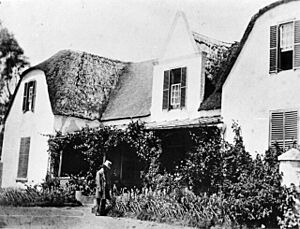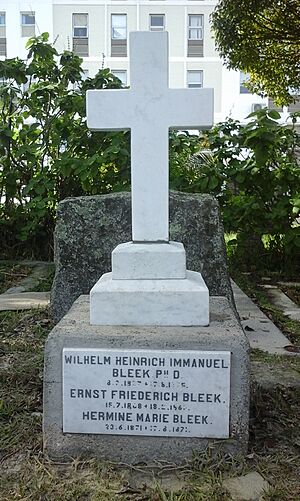Wilhelm Bleek facts for kids
Quick facts for kids
Wilhelm Bleek
|
|
|---|---|

Wilhelm Bleek
|
|
| Born |
Wilhelm Heinrich Immanuel Bleek
8 March 1827 |
| Died | 17 August 1875 (aged 48) Mowbray, Cape Colony
|
| Burial place | Wynberg Cemetery |
| Occupation | German linguist |
| Children | Dorothea Bleek |
Wilhelm Heinrich Immanuel Bleek (born March 8, 1827 – died August 17, 1875) was a German linguist. He studied languages, especially those spoken in South Africa. His most famous work was A Comparative Grammar of South African Languages. He also worked on a huge project with Lucy Lloyd. This project involved collecting texts from the ǀXam and !Kung people. A shorter version of this work was published as Specimens of Bushman Folklore.
Contents
About Wilhelm Bleek
Wilhelm Heinrich Immanuel Bleek was born in Berlin on March 8, 1827. He was the oldest son of Friedrich Bleek, a theology professor. Wilhelm graduated from the University of Bonn in 1851 with a doctorate in linguistics. Before that, he studied in Berlin, where he first became interested in African languages.
His university paper tried to connect North African languages with Khoikhoi languages. At that time, people thought all African languages were linked. After graduating, Bleek worked with a zoologist named Dr. Wilhelm K H Peters. They edited lists of words from East African languages. He learned more about African languages by studying Egyptian Arabic in 1852.
Working in South Africa
In 1854, Bleek was chosen to be the official linguist for an expedition to the Niger River. But he got sick with a tropical fever and had to return to England. There, he met George Grey and Bishop John William Colenso. Bishop Colenso invited Bleek to Natal in 1855 to help write a Zulu grammar.
After finishing the Zulu project, Bleek went to Cape Town in 1856. He became Sir George Grey's official interpreter. He also helped to organize Grey's private library. Grey was interested in languages and supported Bleek's work. Bleek was highly respected as a philologist, which is someone who studies language in written historical sources. He continued his language research and wrote for different publications. He asked missionaries and travelers for examples of African literature. For example, a missionary gave him Namaqua texts in 1861.
In 1859, Bleek briefly went back to Europe because he was not well. But he soon returned to the Cape to continue his research. In 1861, he met Jemima Lloyd, who would become his wife. They met at a boarding house in Cape Town. They wrote letters to each other and got married on November 22, 1862.
The Bleeks first lived in Mowbray. Jemima's sister, Lucy Lloyd, joined their home. Lucy became Bleek's colleague and continued his important work after he passed away.
When George Grey became the Governor of New Zealand, he gave his collection of books to the National Library of South Africa. He said that Bleek should be its curator. Bleek held this job from 1862 until he died in 1875. He also wrote for a newspaper called Het Volksblad. He published the first part of his book, A Comparative Grammar of South African Languages, in London in 1862. The second part came out in 1869. Bleek and Lucy Lloyd often faced money problems, which made their research harder.
Studying the San Language
Bleek first met San people (also called Bushmen) in 1857. He met them when they were prisoners at Robben Island and the Cape Town Gaol. He talked to some of these prisoners. They came from the Burgersdorp and Colesberg areas and spoke a similar "Bushman" language. Bleek really wanted to learn more about this "Bushman" language. He wanted to compare it to older examples of "Bushman" words.
In 1863, a local official named Louis Anthing introduced Bleek to the first ǀXam-speakers. He brought three men to Cape Town from the Kenhardt district. These men were there for legal reasons, but the case was later dropped. In 1866, two San prisoners from near Calvinia were moved to the Cape Town prison. This made it easier for Bleek to meet them. With their help, Bleek made a list of words and sentences. Most of these words came from a man named Adam Kleinhardt.
In 1870, Bleek and Lucy Lloyd started working together. They wanted to learn the "Bushman" language and write down stories and folklore. They found out about a group of 28 ǀXam prisoners at the Breakwater Convict Station. They got permission to bring one prisoner to their home in Mowbray to learn his language. The prison chaplain chose a young man named |a!kunta. But |a!kunta was young and didn't know many of his people's stories. So, an older man named Kabbo was allowed to join him. ||kabbo became Bleek and Lloyd's first real teacher.
Over time, members of ||kabbo's family and other families lived with Bleek and Lloyd in Mowbray. Bleek and Lloyd interviewed them. One of the people interviewed was !Kweiten-ta-Ken. Many of the ǀXam-speakers they interviewed were related. Bleek and Lloyd learned and wrote down their language. They started with lists of words. Then they wrote down stories about their lives, history, folklore, and old beliefs.
Bleek and Lloyd tried to record as much information as possible about the people. This included their family trees, where they came from, and their daily customs. They also took photographs and measurements of everyone they interviewed. This was a common scientific practice at the time. They also asked artists to paint portraits of some of the ǀXam teachers.
Bleek wrote reports about the ǀXam language, literature, and folklore. He sent these reports to the government. He wanted money to continue his studies. He also wanted the government to know how important it was to save San folklore. He believed it was a key part of the nation's history.
Wilhelm Bleek's Death
Wilhelm Bleek died in Mowbray on August 17, 1875. He was 48 years old. He was buried in Wynberg Anglican cemetery in Cape Town. His two young children, who had died before him, were also buried there. His very important work of recording the ǀXam language and stories was continued by Lucy Lloyd. His wife, Jemima, fully supported her. In a newspaper article after his death, he was praised. It said he was a top expert in comparing languages. It also said he was the best at studying and understanding South African languages.
See also
 In Spanish: Wilhelm Bleek para niños
In Spanish: Wilhelm Bleek para niños
- !Kweiten-ta-ǀǀKen
- Kabbo



